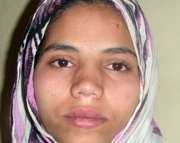
As campaigners for justice in Western Sahara world were preparing to mark the 26th International Day of the Disappeared on 30th August they received news that a 19 year old peace activist, Ms Hawassi Ngiya, had been abducted by Moroccan police.
Ms Ngiya, one of six Saharawi students arrested and beaten after protesting the refusal of Moroccan authorities to allow them to travel to England for a peace workshop on 5th August, had been released following the intervention of human rights groups including Amnesty International but concerns for the student’s safety had remained. These fears proved well founded when, on the evening of Thurdsay 27th, Ms Ngiya was picked up by police in El Aaiun. According to her testimony she was blindfolded, beaten, stripped naked and threatened with rape. After a five-hour torture, the police threw her out of their car naked and shaken on the outskirts of town. 
The conflict in Western Sahara is one of the longest running and most forgotten in the world. Known as Africa’s last colony, Western Sahara was sold to Morocco and Mauritania by the Spanish when they withdrew in 1976. The Mauritanians pulled out soon after and the Moroccans annexed much of the remaining territory in defiance of a ruling from the International Court of Justice. A sixteen-year war ensued between the Moroccans and the Saharawi independence movement, the Polisario Front. Under the terms of a 1991 UN ceasefire agreement, a referendum for self determination was promised, but has been blocked by Morocco.
An estimated 165,000 refugees have lived to live the camps in the inhospitable Algerian desert for over three decades and serious concerns about human rights violations against the Saharawi’s who have remained in Western Sahara have been raised by UN High Commissioner for Human rights and numerous human rights organisations. A 2008 report by Human Rights Watch found that Morocco violated the rights to expression, association, and assembly in Western Sahara. An Amnesty International report of the same year found that “politically motivated administrative impediments have been used to prevent human rights groups obtaining legal registration and curtailing their scope of activities.” There is also widespread evidence of the use of torture.
As signatory to the International Convention for the Protection of All Persons from Enforced Disappearance Morocco should, according to campaigners, reveal the truth about the hundreds of disappeared Saharawis. Once the Convention comes into force, families of the disappeared ought to be entitled to find out what happened to their loved ones, punish the perpetrators and claim reparations. Campaigners are also urging the United Nations Mission for a Referendum in Western Sahara (MINURSO) to assume their responsibilities regarding monitoring human rights violations in the occupied territories. “Since 1975 Saharawi people have been the victims of the disappearances at the hands of the Moroccan authorities” says Yahiaoui Lamine, Polisario’s UK representative. “The latest victim, a young Saharawi girl who dared to challenge discrimination, shows that disappearances are a reality for the people of Western Sahara”.
 Over the past three decades more than 500 indigenous Saharawi who have challenged the illegitimacy of the Moroccan occupation of Western Sahara have ‘disappeared’. For their families the International Day of the Disappeared is a day of dignified remembrance, a day of profound pain, and a day of justified anger. To suggest Hawassi Ngiya, bruised and traumatised, should count herself lucky, is almost obscene. But at least her name has not been added to the ever-lengthening list of the disappeared.
Over the past three decades more than 500 indigenous Saharawi who have challenged the illegitimacy of the Moroccan occupation of Western Sahara have ‘disappeared’. For their families the International Day of the Disappeared is a day of dignified remembrance, a day of profound pain, and a day of justified anger. To suggest Hawassi Ngiya, bruised and traumatised, should count herself lucky, is almost obscene. But at least her name has not been added to the ever-lengthening list of the disappeared.
Stefan Simanowitz is a journalist and human rights campaigner. Visit here for more on Western Sahara.

